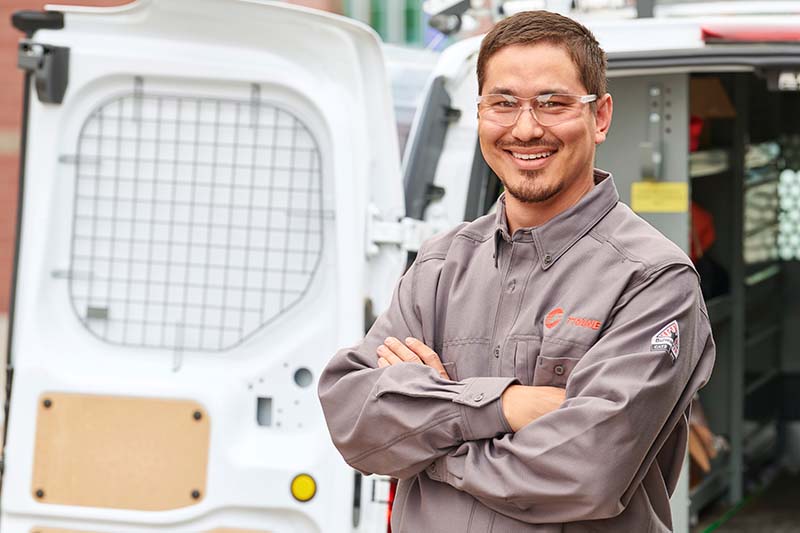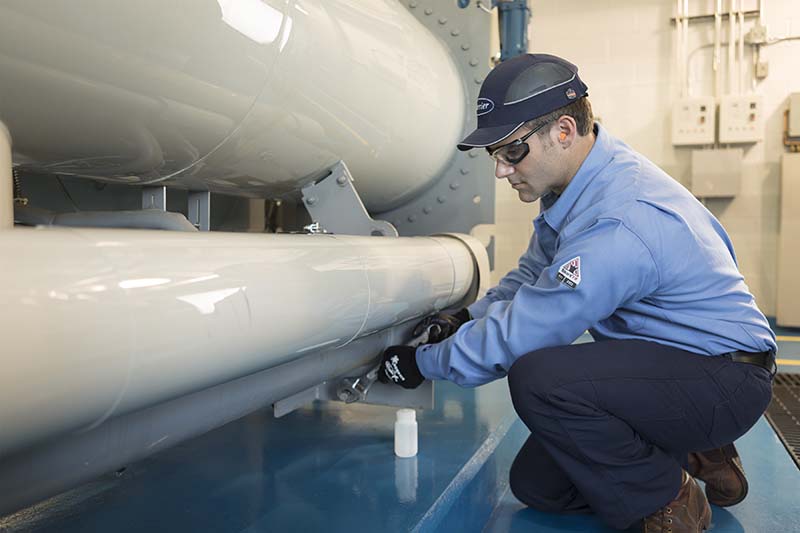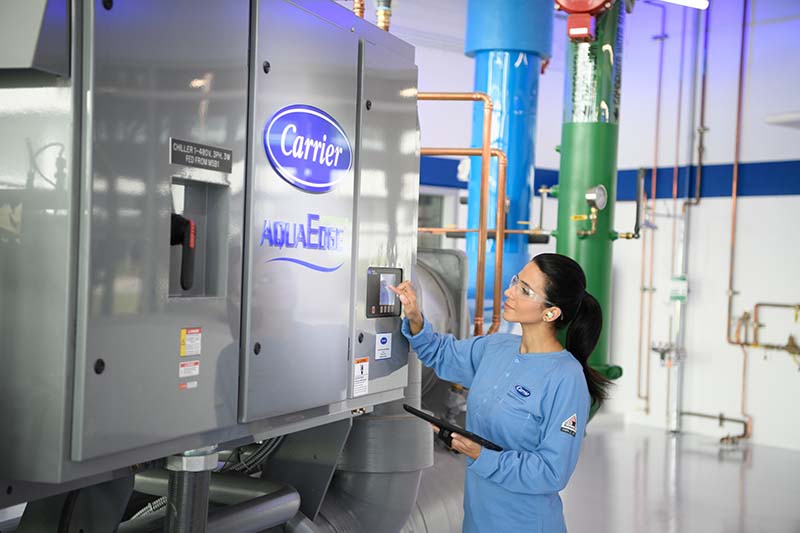As lockdowns due to the COVID-19 pandemic are winding down in many areas, some workers are returning to their office buildings for the first time in months. Unfortunately, this influx of employees coincides with many buildings buttoning up for winter — potentially reducing ventilation — as well as what is traditionally the start of flu season in the U.S. There are also concerns that COVID-19 infections could spike again later this year.
According to the Centers for Disease Control (CDC), both flu and COVID-19 viruses are primarily spread through the air. This mainly occurs when tiny droplets expelled by infected people when they cough, sneeze, or talk impact or are inhaled by others who are in close proximity. Those droplets may be concentrated in areas with low ventilation rates, potentially increasing the risk for virus spread, which is why experts are recommending not only increased ventilation, but also better filtration in most commercial buildings.
The Role of HVAC
At the beginning of the COVID-19 pandemic, little was known about how the virus spread, and there was concern that it could be transmitted through HVAC systems. As a result, ASHRAE and other organizations quickly offered detailed guidance regarding how to potentially mitigate virus transmission through the modification of commercial HVAC systems.
Since then, nothing has happened that would change ASHRAE guidance; however, the case for airborne transmission of the COVID-19 virus seems to be getting stronger and gaining more widespread acceptance, said William Bahnfleth, ASHRAE presidential member, ASHRAE Epidemic Task Force chair, and professor of architectural engineering at Pennsylvania State University.

DIFFERENT NEEDS: There is no single solution for all environments, as every building is different and each one may have different needs and variables when it comes to indoor air quality. Courtesy, Trane
“An extensive analytical study of the Diamond Princess cruise ship incident, which has its critics, concluded that aerosol transmission was highly likely and probably responsible for a large percentage of cases,” he said. “Another development is the publication of a pre-print by the University of Oregon that reported identification of SARS-CoV-2 RNA in multiple locations inside air handling units in a hospital. This was followed more recently by a pre-print from the University of Florida reporting sampling of active SARS-CoV-2 virus in patient rooms in a hospital. Additionally, a new study reports on a nursing home outbreak in the Netherlands that appears to be the result of inadequate ventilation.”
Bahnfleth added that while the Oregon hospital study demonstrates that SARS-CoV-2 can be transmitted through HVAC systems — which he never doubted was possible — it does not establish that COVID-19 has actually been transmitted by this route.
While there is no new evidence that COVID-19 can be spread by HVAC systems specifically, new studies show how the virus can be transmitted through airflow, said David Budzinski, vice president of commercial excellence at Johnson Controls.
“Since HVAC controls airflow, there has been an increased focus on particle size and how virus-sized particles specifically are transmitted through airflow,” he said. “With this knowledge, we can recommend and implement appropriate HVAC solutions like increased filtration and outdoor air systems, as well as some traditional anti-virus mechanisms like UV lighting.”
Recommendations
When it comes to mitigating the risk of indoor microbiological transmission, including the SARS-CoV-2 virus, the consensus continues to be that it can be achieved via four primary indoor air quality pillars: dilution, exhaust, contain, and cleaning, said Ron Cosby, thermal systems and technology leader at Trane Technologies.
“The dilution comes from outside air ventilation to remove viruses via fresh air replacement, which effectively increases the outside air exchanges per hour,” he said. “The exhaust tenet revolves around ensuring that areas with limited airflow, such as bathrooms, have a mechanism to exhaust air to continually refresh the air. Our suggestion is to operate exhaust continuously.”
Contain involves maintaining humidity levels at ASHRAE-suggested levels of 40 to 60 percent relative humidity, said Cosby, which helps prevent rapid evaporation of any droplets or aerosols that may contain viruses. Smaller water droplets or aerosols may hang in the air longer and increase the risk of infection, he said, and there have also been studies for previous coronaviruses that indicate the body reacts differently in lower humidity levels.

REDUCE THE SPREAD: A generation of research and experience has proven that when properly maintained and operated, HVAC can reduce the spread of viruses. Courtesy, Carrier
“Maintaining humidity indoors will help to reduce the potential of infection and reduce the potential severity of illness,” he noted. “Finally, commercial HVAC systems can go on the offense through use of cleaning technologies to actively reduce the number of microbiologicals that may be in the air or on surfaces.”
Increasing the level of air filtration is also a relatively easy way to reduce potential indoor virus particles, but the type of filter needed depends on the specific building, said Budzinski. For most buildings, Johnson Controls recommends using filters with a MERV 13 rating, or as high as MERV 16 for certain applications. HEPA filters are also available and are becoming more common in commercial buildings.
“There is no one-size-fits-all solution for upgrading HVAC systems in this situation,” he noted. “It is also beneficial to have a significant amount of outdoor air mixed with the indoor air. A 10 percent outdoor to indoor air ratio is a great starting point for many spaces, but some facilities are choosing to go as high as 30 percent outdoor. Because of this, we are seeing an increased demand for dedicated outdoor air systems (DOAS). In situations where a DOAS unit would be too large, a smaller recovery ventilator can achieve satisfactory results without a major HVAC system upgrade.”
As for air cleaning technologies such as ultraviolet germicidal irradiation (UVGI), photocatalytic oxidation, and bipolar ionization, these can be helpful in many cases, but better filters are often the best first course of action.
“The quickest and most cost-effective way to enhance air cleaning is by upgrading HVAC filters to ones that more aggressively capture certain microbiological particles,” said Cosby. “ASHRAE recommends upgrading filters to a minimum of a MERV 13 filter, but these upgrades need to be done with the understanding that it could come at a price of increased energy consumption with increased pressure drop.”
Energy Penalties
Slowing the spread of COVID-19 is a team sport, and proper ventilation and enhanced filtration are important parts of the solution, along with hand washing and social distancing, said Chris Opie, vice president of product management and marketing at Carrier HVAC and leader of Carrier Commercial HVAC Healthy Buildings Program. However, increasing outside air ventilation to 100 percent while maintaining indoor comfort levels will likely not be possible in most commercial HVAC systems that were not designed to do so in the first place.

ADDRESS ISSUES: In terms of maintenance, it is recommended that HVAC and control systems be fully recommissioned with any known issues addressed, prior to a building reopening. Courtesy, Carrier
“Any HVAC system that is equipped with a modern digital control system should have the capability to accept control sequence modifications to address the suggested current guidance, but the design capacity of the equipment will dictate the degree to which a given system can be made to comply,” he said. “Updated sequences may also require additional instrumentation along with control logic updates. In many cases, full compliance may mean mechanical, as well control system updates.”
Another concern is that increasing ventilation and humidity levels in cold weather, as well as in hot summer climate conditions, will likely result in energy penalties in all but the most moderate climates, said Opie.
“Building owners can partially mitigate the energy penalty that comes with changes to their HVAC operation by taking advantage of energy-saving strategies that may exist in their building automation system, if one is present,” he said. “Supply air setpoint reset, addressing limited occupancy by placing continuously unoccupied zones into temporary setback, demand-limiting non-essential equipment, and expanding overall comfort setpoints are just a few options that should be easy to implement in a contemporary building automation system. Owners can also consider added features and equipment like exhaust air energy recovery and DOAS units.”
In the past, building owners often limited the intake of outdoor air to reduce operating costs, but they need to understand that there are new IAQ priorities now, which include significantly increasing the amount of fresh air being used to ventilate and dilute the air, said Cosby.
“A best practice is to consistently run an HVAC system to remove stagnant air from the room and replace it with fresh clean air,” he said. “We also recommend that building operators change the setpoints on the HVAC system’s fresh air dampers that regulate the intake of outdoor air into a building. Increasing airflow from the outdoors flushes out stale indoor air to help remove microbiologicals, which may include certain viruses and other contaminants. Building operators may also want to disable any demand-controlled ventilation originally set up to reduce outdoor airflow to save energy.”
Increased ventilation with outdoor air is likely to increase energy use, which is undesirable, said Bahnfleth; however, he believes new methods are evolving to address that concern. One possible lower-cost option that he sees emerging combines the effects of ventilation and filtration — and possibly other types of air cleaners — to achieve an equivalent air change rate target.
“For example, if a portable HEPA filter unit with a clean air delivery rate of two air changes per hour is placed in a room that is ventilated with two air changes per hour of outdoor air, the space has a total removal rate of about four air changes per hour,” he said. “Recommendations for what the target should be vary with the source, from about three on the low end to five or six on the high end. The energy impact of engineering controls will certainly be considered when changes to standards related to COVID-19 are proposed. That is still some time in the future. We need to absorb the lessons of this experience first and also think about the bigger picture of other infectious diseases that may be epidemic in the future, including seasonal influenza.”
While increased outdoor air ventilation may result in an energy penalty for building owners, the impact really depends on what is done with the individual system from a service and equipment perspective, noted Cosby.
“If recommissioning is conducted for a building reopening to ensure proper equipment operation and controls methodologies for enhanced indoor air quality, the building owners may see energy consumption improvements, especially if they begin economizing more in the winter,” he said. “Additionally, equipment upgrades as part of an improved indoor air quality package can deliver energy savings, so recommissioning of buildings and equipment or new equipment installs may assist building owners in the long run.”
Long-Term Effect
Due to the tremendous impact of the pandemic, there will likely be long-term effects in the way commercial HVAC systems are designed and constructed. While these effects are difficult to predict, it is possible that significant changes related to ventilation and air distribution systems could be mandated in the future, said Opie.

REMOTE CONTROL: Carrier offers MyWay, an automation platform that integrates HVAC and other system controls, as part of its healthy buildings program. Avoiding contact is crucial to preventing the spread of diseases.
“Improving ventilation and filtration is a current focus, and we know how to do that, albeit with a commensurate energy penalty for many climate zones,” he said. “However, current studies are looking at airflow patterns in addition to ventilation as a contributor to infectious disease transmission in an enclosed space. Underfloor and thermal displacement air distribution systems, or other system types that promote vertical airflow patterns versus traditional systems, may help reduce the incidents of person-to-person transmission. This can be addressed long-term in new building designs and internal arrangement of the building occupants. Retrofitting existing buildings will present greater challenges to improve ventilation and filtration.”
Design and operational changes related to the pandemic are already happening in new construction, said Budzinski, who noted that some office buildings and critical spaces are starting to use HVAC systems that follow standards typically found in healthcare facilities. These system changes will also have an influence on how certain commercial buildings are operated.
“In the long-term, people will be very conscious of elements that contribute to healthy spaces, like touchless environments and technology for airborne particle removal,” he said. “We are driving this change with our customers by launching new technologies and services aimed at helping them come back to their facilities safely.”
Exploding Demand For IAQ
Written by Ted Craig, Business Management Editor
The HVAC industry is ready to help provide healthy indoor air with a range of products and services. These include performing evaluations, monitoring IAQ, and providing solutions for ventilation, filtration, and disinfection.
TSI Inc. makes instruments in a variety of sizes for professionals to monitor for IAQ, occupational hygiene, and other purposes.
“We are seeing demand expand, particularly for indoor air quality,” said Kevin Chase, TSI’s global product manager for exposure monitoring and IAQ.
Chase said TSI’s equipment can’t monitor for viruses like COVID-19, but it does detect ultrafine particulates, which can act as a proxy. The company’s products are getting interest from a new group of customers. For example, medical offices want to monitor particulates in a room after one patient leaves to determine how soon another patient can enter. Beyond trying to prevent spreading the coronavirus, there is a trend to detect wide range of IAQ parameters, Chase said.
RGF Environmental Group Inc. has seen enough demand for its IAQ products that it made a major investment ensure they are available.
“It is becoming increasingly more difficult to obtain indoor air quality products,” said Mathew Charles, vice president of RGF’s air products division. “As the current pandemic continues to swell, so does the demand and awareness for air purification products. RGF has been facing many of the same challenges as other manufacturers in obtaining key components to produce over 500 different environmental products.”
In January, RGF had purchased a 24,000-square-foot building to meet its expected demand for the year. Once the pandemic hit, the company accelerated its three-month plan to one month. This included spending $2 million in new equipment that was installed and operating in record time.
RGF developed new programmable drilling fixtures and is implementing robotic automation methods to improve productivity and quality. The company tripled its workforce, in part so it could run its metal fabrication and product assembly lines around the clock. To further avoid production delays, RGF signed on with several new hardware suppliers and fabrication houses.
RGF’s most popular product is photohydroionization (PHI), an oxidation technology that minimizes and neutralizes indoor air pollutants such as bacteria, viruses, mold, gases (VOCs), and odors. PHI utilizes a broad-spectrum, high-intensity UV light targeted on a hydrated quad-metallic catalyst surface.
Charles said the company was declared a critical manufacturer by the Department of Homeland Security. This meant RGF’s facilities kept operating during the worst of the pandemic, but the company had to prioritize hospitals, healthcare facilities, and first responders. Now it can focus more broadly for other customers. And demand from those customers remains extremely strong.
“There is no end in sight, Charles said. “We haven’t even hit our baseline. With the increased awareness of the importance of indoor air quality, businesses will to continue to take the necessary steps to protect their customers and employees. The pandemic has led to a whole mindset change.”



Report Abusive Comment